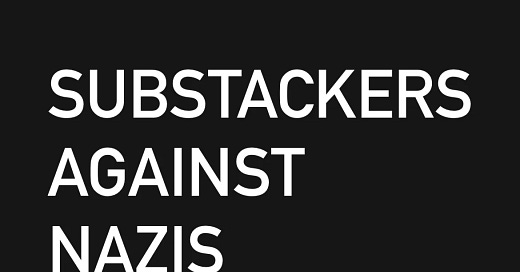BUSINESS DEP’T.
WHO IS RESPONSIBLE for what gets published on a publishing platform? The Indignity newsletter is published through the platform called Substack, which underwrote our first year of operation with grant funding through its Substack Pro program and which currently subsidizes our access to Getty Images, for illustrations. Our direct interactions with Substack have been generally useful and helpful in supplying you, the readers, with the newsletters we want to write.
But Substack is a much larger enterprise than our one newsletter, and Substack users have been grappling for a long time with what it means to be connected to that enterprise. Although the company talks about its mission in terms of supporting the general principle of free expression, it has shown a longstanding tendency—in the tech-libertarian mode of Silicon Valley—to identify free expression with terrible expression.
In the early days of the platform, for instance, this meant that its roster of showcase bloggers was well supplied with the kind of contrarians who wanted to be contrary about whether trans people really deserved rights. "Substack" became a popular shorthand for a certain kind of sour culture-war entrepreneurship, a barracks for people who had been canceled, or who had preemptively canceled themselves, and were now reinventing themselves as commanders in the war against whatever was being called "wokeness."
This was frustrating for the other writers doing all the other kinds of writing on the platform, who did not want their own work to be identified with that of reactionary clowns. Things got even more frustrating recently, when Substack leadership began outright promoting the likes of Richard Hanania, a genuinely vile racist, as exemplifying the platform's potential for expanding the discourse. When asked about this, by Substack users like Jonathan M. Katz, the champion of discourse who run the site simply refused to answer.
Further reporting by Katz turned up the fact that among the newsletters currently operating on Substack are publications run by outright Nazis, who are making money by using Substack's tools to collect subscriptions from their supporters. Despite its many pronouncements about the value of unfettered expression, Substack is not an anything-goes zone; it enforces restrictions against sexual material, for instance, and its terms of service officially say that endorsing racist violence is off limits. And yet there are the Nazis.
At some point—that point being now, more or less—something has to give. This week, a collection of publishers who use the Substack platform have been posting copies of the following open letter, addressed to the people who run what Rusty Foster of Today in Tabs has long called "Our Regrettable Platform." Rusty, for one, has already announced he's bailing out for a new host. Indignity is waiting, for now, to see if Substack sticks to its old policy of pretending its problems aren't problems, or whether it is willing to kick out the Nazis.
Substackers Against Nazis: A collective letter to Substack leadership
Dear Chris, Hamish & Jairaj:
We’re asking a very simple question that has somehow been made complicated: Why are you platforming and monetizing Nazis?
According to a piece written by Substack publisher Jonathan M. Katz and published by The Atlantic on November 28, this platform has a Nazi problem:
“Some Substack newsletters by Nazis and white nationalists have thousands or tens of thousands of subscribers, making the platform a new and valuable tool for creating mailing lists for the far right. And many accept paid subscriptions through Substack, seemingly flouting terms of service that ban attempts to ‘publish content or fund initiatives that incite violence based on protected classes’...Substack, which takes a 10 percent cut of subscription revenue, makes money when readers pay for Nazi newsletters.”
As Patrick Casey, a leader of a now-defunct neo-Nazi group who is banned on nearly every other social platform except Substack, wrote on here in 2021: “I’m able to live comfortably doing something I find enjoyable and fulfilling. The cause isn’t going anywhere.” Several Nazis and white supremacists including Richard Spencer not only have paid subscriptions turned on but have received Substack “Bestseller” badges, indicating that they are making at a minimum thousands of dollars a year.
From our perspective as Substack publishers, it is unfathomable that someone with a swastika avatar, who writes about “The Jewish question,” or who promotes Great Replacement Theory, could be given the tools to succeed on your platform. And yet you’ve been unable to adequately explain your position.
In the past you have defended your decision to platform bigotry by saying you “make decisions based on principles not PR” and “will stick to our hands-off approach to content moderation.” But there’s a difference between a hands-off approach and putting your thumb on the scale. We know you moderate some content, including spam sites and newsletters written by sex workers. Why do you choose to promote and allow the monetization of sites that traffic in white nationalism?
Your unwillingness to play by your own rules on this issue has already led to the announced departures of several prominent Substackers, including Rusty Foster and Helena Fitzgerald. They follow previous exoduses of writers, including Substack Pro recipient Grace Lavery and Jude Ellison S. Doyle, who left with similar concerns.
As journalist Casey Newton told his more than 166,000 Substack subscribers after Katz’s piece came out: “The correct number of newsletters using Nazi symbols that you host and profit from on your platform is zero.”
We, your publishers, want to hear from you on the official Substack newsletter. Is platforming Nazis part of your vision of success? Let us know—from there we can each decide if this is still where we want to be.
Signed,
Substackers Against Nazis






